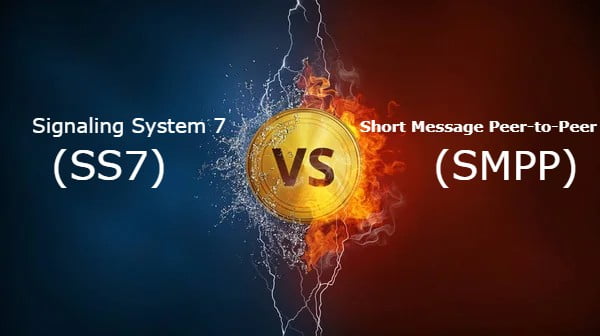In the realm of mobile communications, various protocols are instrumental in ensuring efficient and reliable message delivery. Two prominent protocols that play critical roles in the mobile ecosystem are SS7 (Signaling System 7) and SMPP (Short Message Peer-to-Peer). Both protocols serve distinct purposes and are widely used in different contexts. This article aims to provide a detailed comparison of SS7 vs SMPP, highlighting their features, functionalities, and areas of application.
Contents
Overview of SS7 (Signaling System 7)
SS7, also known as C7 (Common Channel Signaling System 7), is a global standard for telecommunications signaling. It was developed in the 1970s and is predominantly used in traditional circuit-switched networks. SS7 facilitates the exchange of control and signaling information between network elements, enabling services such as voice calls, SMS messaging, and intelligent network features.
Key Features of SS7
a. Signaling Network Architecture: SS7 employs a hierarchical architecture comprising multiple network nodes, including Service Switching Points (SSPs), Signal Transfer Points (STPs), and Service Control Points (SCPs). These nodes cooperate to establish and manage communication sessions.
b. Signaling Transport: SS7 utilizes out-of-band signaling, which means signaling messages travel on dedicated signaling channels separate from voice or data channels. This ensures efficient and reliable communication between network elements.
c. Signaling Protocols: SS7 employs a suite of signaling protocols, including SCCP (Signaling Connection Control Part), ISUP (ISDN User Part), and MAP (Mobile Application Part). These protocols enable various functionalities, such as call setup, call routing, and subscriber authentication.
Overview of SMPP (Short Message Peer-to-Peer)
SMPP is a protocol specifically designed for the exchange of SMS messages between Short Message Service Centers (SMSCs) and external applications. It operates over TCP/IP and has gained widespread adoption in mobile messaging services, particularly in the context of SMS aggregators, bulk messaging platforms, and mobile marketing campaigns.
Key Features of SMPP
a. Peer-to-Peer Communication: SMPP allows direct peer-to-peer communication between an External Short Message Entity (ESME) and an SMSC. This enables seamless message transmission and delivery tracking.
b. Message Types and Encoding: SMPP supports various types of messages, including text messages, binary messages, and Unicode messages. It also provides options for message encoding, allowing efficient transmission of different content types.
c. Error Handling and Delivery Receipts: SMPP incorporates error handling mechanisms, allowing the detection and resolution of delivery failures. It also provides delivery receipts, enabling senders to track the status of their messages.
Comparison of SS7 vs SMPP
a. Use Cases: SS7 is primarily utilized in traditional telecom networks to support voice calls, SMS, and advanced services like call forwarding and number portability. On the other hand, SMPP is focused specifically on SMS messaging, making it the protocol of choice for bulk messaging services, mobile marketing campaigns, and SMS aggregators.
b. Message Types and Content: SS7 supports various types of messages beyond SMS, including voice, data, and multimedia. SMPP, however, is solely dedicated to SMS messaging and does not cater to other communication mediums.
c. Network Infrastructure: SS7 relies on dedicated signaling network infrastructure, which is typically managed by telecom operators. In contrast, SMPP operates over standard TCP/IP networks, making it easier to integrate with existing IT infrastructure and deploy in various environments.
d. Security: SS7 has faced security concerns in recent years, with vulnerabilities that can be exploited for activities like call interception and location tracking. SMPP, on the other hand, benefits from being a relatively simpler and more focused protocol. While it is not completely immune to security threats, the scope for exploitation is generally lower compared to SS7. Additionally, SMPP supports encryption mechanisms such as TLS (Transport Layer Security) for secure message transmission, providing an added layer of security.
e. Scalability and Performance: SS7 has been designed to handle high call volumes and support complex signaling scenarios in traditional telecom networks. It is well-suited for large-scale deployments and can efficiently handle voice calls, SMS, and other services. SMPP, on the other hand, excels in handling SMS traffic and is optimized for high-throughput message delivery. It offers good scalability and performance specifically for SMS-related applications.
f. Industry Adoption: SS7 has been the backbone of traditional telecom networks for decades and is widely adopted by network operators around the world. It forms an essential part of the global telecommunication infrastructure. SMPP, on the other hand, has gained significant popularity in the mobile messaging industry, especially in the domain of SMS aggregators, bulk messaging providers, and mobile marketing companies.
g. Evolution and Future Trends: While SS7 continues to be an integral part of legacy telecom networks, the industry is gradually transitioning towards IP-based signaling protocols such as Diameter and SIP (Session Initiation Protocol) for Next-Generation Networks (NGNs). This shift enables the convergence of voice, data, and multimedia services over IP networks. SMPP, on the other hand, remains relevant and widely used in the SMS messaging ecosystem, with ongoing enhancements and updates to cater to evolving messaging needs.
Conclusion
In summary, SS7 and SMPP are two important protocols that serve distinct purposes in the mobile communication landscape. SS7 plays a crucial role in traditional telecom networks, enabling voice calls, SMS messaging, and advanced telephony services. SMPP, on the other hand, specializes in SMS messaging and is widely utilized by SMS aggregators, bulk messaging providers, and mobile marketing campaigns.
Both protocols have their strengths and areas of application, and their continued evolution ensures the efficient and reliable delivery of messages in different contexts. Understanding the features and capabilities of SS7 and SMPP is essential for professionals working in the telecommunications and mobile messaging industries, allowing them to choose the appropriate protocol for their specific requirements.
